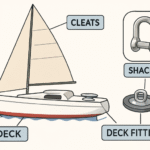Remember desperately stuffing keywords into every link, hoping Google would notice? You know the ones: awkwardly jammed into sentences, feeling about as natural as a penguin in the Sahara. What if that whole approach is not just outdated, but actively holding your site back?
Forget everything you knew about anchor text. Anchor 2.0 isn’t a minor tweak; it’s a fundamental shift in how search engines understand – and reward – the way we connect ideas online. It’s about building bridges users actually want to cross, signaling trust to algorithms, and future-proofing your link profile. Let’s ditch the robotic tactics and build links that resonate.
What Exactly is Anchor 2.0? (Beyond the Buzzword)
Think of Anchor 2.0 as moving from shouting keywords to having a genuine conversation. It’s ditching the blunt instrument for a precision tool focused on relevance and user value.
- The Death of “Click Here” (Keyword stuffing is dead): Seriously, “click here,” “learn more,” and those painfully forced exact-match keywords? They’re relics. Search engines have gotten incredibly sophisticated. They don’t just see the anchor text; they see the entire context surrounding the link – the paragraph it’s in, the page topic, the user’s likely intent. Stuffing keywords looks manipulative and offers zero value to the person reading.
- Context is King (How search engines interpret links now): Anchor 2.0 thrives on semantic understanding. It’s about the link making sense right here, right now. Does the anchor text naturally describe why someone might want to click? Does it fit seamlessly into the narrative? Does it provide useful information about the destination before the user even goes there? That’s the gold standard.
Traditional Anchors vs. Anchor 2.0 Approach
| Feature | Traditional Anchor | Anchor 2.0 Approach |
| Focus | Keyword Exact Match | Semantic Relevance & User Intent |
| Text Example | “best SEO tools” | “These analytics features helped improve our traffic” |
| Goal | Pass Ranking Power | Provide Context & Value |
| User Exp. | Often Jarring | Feels Natural & Helpful |
Why Anchor 2.0 Matters More Than Ever (The Core Benefits)
This isn’t just an SEO fad; it’s about aligning with where the web is headed. Ignoring it is like trying to win a Formula 1 race with a horse and cart.
- Winning the “EEAT” Game (Expertise, Authoritativeness, Trustworthiness): Google’s EEAT framework is huge. Anchor 2.0 directly signals expertise and trustworthiness. When your links provide clear, valuable context, you show both users and algorithms that you understand the topic deeply and are guiding them to genuinely helpful resources. It’s about building authority, not just links.
- Reducing Bounce Rates (Links users want to click): Ever clicked a link because the anchor text promised something specific, only to land on a page that had nothing to do with it? Frustrating, right? That’s a guaranteed bounce. Anchor 2.0 links set accurate expectations. When users click a link described as “our detailed case study on local SEO success,” they know what they’re getting. They’re more likely to stay, read, and engage. Happy users are a ranking signal Google loves.
- Future-Proofing Your Link Profile (Algorithms evolve): Search engines are constantly getting better at understanding natural language and user intent. Tactics that rely on manipulation (like keyword stuffing) become less effective and more risky over time. Anchor 2.0 is inherently sustainable because it’s built on relevance and user value – principles that will always matter.
Implementing Anchor 2.0 in Your Content: A Practical Guide
Okay, theory is great, but how do you actually do this? It’s simpler than you think, but it requires a shift in mindset.
- Auditing Your Existing Anchors (Tools & Methods): Start by facing the music. Pick a few key pages (your top-performing blog posts, cornerstone content, product pages). Use a tool like Screaming Frog SEO Spider (crawl the page) or even just manually scan. Look for:
- “Click here,” “read more,” “this page,” etc.
- Overly optimized exact-match keywords that feel forced.
- Anchors that are too vague to understand the destination.
- Repetitive anchors pointing to the same page. Flag anything that makes you cringe slightly.
- Writing Anchors That Feel Human (Step-by-Step): This is the heart of Anchor 2.0. Next time you add a link, pause. Follow these steps:
- Understand the Destination Page: What’s its core purpose? What problem does it solve? What key insight does it offer? Don’t just think “keyword,” think “value.”
- Analyze the Surrounding Text: What’s the sentence and paragraph actually about? What point are you making right here?
- Ask: “What Would a Helpful Human Say?” Imagine explaining this link to a colleague over coffee. How would you naturally describe it? “Check out this guide” is okay, but “this step-by-step guide to fixing broken links” is better. “See our pricing” is functional, but “see how our plans save time for teams like yours” connects value.
- Prioritize Clarity & Value: Tell users why they should click. What benefit do they get? What question does it answer? Be descriptive.
- Vary Anchor Text Naturally: Don’t force variation, but let it happen organically. Use synonyms, partial matches (if truly relevant), brand names (for your own site/products), and even the title of the destination page. “Neil Patel’s guide to content marketing” and “this expert breakdown of content funnels” are both valid for the same link, depending on context.
- Tools to Help You Master Anchor 2.0:
- Your Brain & Read-Aloud Test: Still the best tool. Does it sound natural when spoken?
- SEO Crawlers (Screaming Frog, Sitebulb): For audits and identifying patterns.
- Grammar/Readability Checkers (Hemingway, Grammarly): Flag complex sentences where anchors might get lost. Aim for clarity.
- Spreadsheets: For tracking audits and planned rewrites.
Read also: adsy.pw/hb3: The AI-Powered Advertising Revolution You Can’t Afford to Miss
Anchor 2.0 Myths Debunked (Setting the Record Straight)
Let’s clear up some common confusion floating around:
- “Exact Match Anchors Are Dead” (Not dead, just nuanced): Okay, maybe “dead” is too strong. They’re not inherently evil if they occur naturally and are highly relevant. If you’re writing naturally about “the best coffee grinders” and linking to your detailed review, using “best coffee grinders” as the anchor can be perfectly fine Anchor 2.0 – if it flows naturally in that specific sentence. The problem is forcing them everywhere.
- “Anchor 2.0 Means Ignoring Keywords Completely” (False! Relevance is key): This is a big misunderstanding. Anchor 2.0 isn’t anti-keyword; it’s pro-relevance. Keywords are still signals of topic. The shift is how you use them. Instead of jamming in the exact phrase, focus on semantically related terms and natural descriptions that convey the meaning and value of the link. Keywords are part of the context, not the sole dictator.
- “It’s Too Much Work for Little Gain” (Long-term authority is priceless): Auditing and updating takes effort, no sugarcoating it. But the gain? It’s substantial and compounding. Better user engagement (lower bounce rates, longer time on site), stronger EEAT signals leading to improved rankings and trust, and a link profile resilient against algorithm updates. This isn’t a quick trick; it’s foundational SEO hygiene that builds lasting authority. Start small – audit and fix key pages first.
Conclusion & Your Next Move
Anchor 2.0 boils down to this: linking like a helpful human, not a keyword-obsessed robot. It’s about understanding that every link is a tiny user experience moment and a signal of your site’s expertise. By prioritizing context, clarity, and genuine value in your anchor text, you win on multiple fronts: happier users who stick around, stronger trust signals for search engines, and a more resilient, future-proof website.
Ready to try Anchor 2.0? Here’s Your Action Plan:
- Audit One Page: Pick one important blog post or product page right now. Scan its links. How many vague or forced anchors do you spot? Be honest!
- Rewrite Two Anchors: On that same page, pick the two worst offenders. Rewrite them using the “What Would a Helpful Human Say?” test. Focus on describing the benefit or content of the page you’re linking to. Make it natural within the sentence.
- Check Your Main Navigation: Look at your primary menu links. Are they descriptive (“Our Sustainable Manufacturing,” “Client Success Stories”) or generic (“Services,” “About”)? Even small improvements here make a big UX difference. Aim for clarity and value.
What’s the most cringe-worthy “old school” anchor text you’ve ever seen (or maybe even used!)? Share your link horror stories – or your Anchor 2.0 successes – in the comments below! Which tip are you tackling first?
FAQs
- Q: Is Anchor 2.0 just about using long-tail keywords?
- A: Not exactly. It’s about relevance and context. A short, descriptive phrase (“2024 SEO trends report”) can be perfect Anchor 2.0, while a forced long-tail (“best comprehensive guide to 2024 SEO trends for beginners”) might feel unnatural. Focus on natural description over keyword length.
- A: Not exactly. It’s about relevance and context. A short, descriptive phrase (“2024 SEO trends report”) can be perfect Anchor 2.0, while a forced long-tail (“best comprehensive guide to 2024 SEO trends for beginners”) might feel unnatural. Focus on natural description over keyword length.
- Q: Does Anchor 2.0 apply to external links I control (e.g., guest posts)?
- A: Absolutely! While you have less control over others linking to you, Anchor 2.0 principles are crucial for links you build or influence. Aim for contextual relevance in your guest post bio links, resource page outreach descriptions, and even social media shares pointing to your site.
- A: Absolutely! While you have less control over others linking to you, Anchor 2.0 principles are crucial for links you build or influence. Aim for contextual relevance in your guest post bio links, resource page outreach descriptions, and even social media shares pointing to your site.
- Q: Won’t varying anchor text hurt my rankings for my target keyword?
- A: Contrary to old beliefs, natural variation is good and expected. Search engines understand synonyms and context far better now. Anchor 2.0 focuses on overall relevance to the linked page’s topic, which signals stronger topical authority than repetitive exact matches (which can actually look manipulative). The linked page’s content defines its target keywords, not just the anchor text pointing to it.
- A: Contrary to old beliefs, natural variation is good and expected. Search engines understand synonyms and context far better now. Anchor 2.0 focuses on overall relevance to the linked page’s topic, which signals stronger topical authority than repetitive exact matches (which can actually look manipulative). The linked page’s content defines its target keywords, not just the anchor text pointing to it.
- Q: How often should I audit my anchor text?
- A: For most sites, a comprehensive audit every 12-18 months is sufficient. However, do spot checks after major content overhauls or if you notice changes in traffic/engagement on key pages. Prioritize Anchor 2.0 audits on your most important pages (money pages, cornerstone content, high-traffic blogs).
- A: For most sites, a comprehensive audit every 12-18 months is sufficient. However, do spot checks after major content overhauls or if you notice changes in traffic/engagement on key pages. Prioritize Anchor 2.0 audits on your most important pages (money pages, cornerstone content, high-traffic blogs).
- Q: Can Anchor 2.0 help with voice search?
- A: Yes, significantly! Voice search queries are inherently conversational. Anchor 2.0 anchors, being natural, descriptive, and context-driven, align perfectly with how people speak and ask questions verbally. This makes your content more likely to surface and satisfy voice search intent.
You may also like: eworldexternal.com: Your All-in-One Digital Hub for Work, Learning, and Growth











